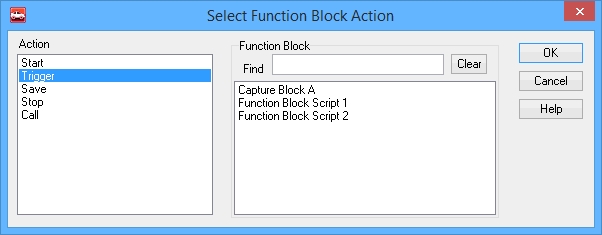Script Type Function Block Command: Function Block Action
Command Description
The Function Block Action command allows one function block script to control the operation of another.
Value Column Parameters
Double-click the Value column to bring up a dialog box to define command settings (Figure 1). There are two parameters to select: the action to take, and the function block to apply the action to.

Action
Specifies the action to be taken:
Start: Start the selected function block if it is not running.
Trigger: Trigger a Capture Type Function Block that is currently waiting to be triggered. To use this option you must select a capture type block, and its collection method must be either Collect before and after a trigger expression or Collect before and after a manual trigger as specified in the Stop and Trigger Tab.
Save: Save the data collected by a capture block.
Stop: Stop the selected function block if it is currently running.
Call: Start the function block and then wait until it is finished.
Function Block
The function block upon which to perform the action. All function blocks in the current setup will be listed in the large white box at bottom right; select one and then press the OK button.
The Find box allows you to more easily find the right function block in setups where there are many. Type a string in the box to filter the list of function blocks shown in the selection box, so that only those that match the entered string appear. Press Clear to resume showing all function blocks again.
Example
Figure 2 shows a "real world" example of how the Function Block Action command can be used. The setup in question is designed to run in a CoreMini on an ICS hardware device with two nodes. In addition to the script shown, the setup has two others: Node A Send Data, designed to run in Node A of the device, and Node B Send Data, designed to run on Node B. These two scripts have their Start Type set to Manual so they do not run when the device is turned on, while the script in Figure 2 runs immediately. It begins by querying the device's serial number; if it is even, this means the script is running on Node A, so the script starts Node A Send Data; otherwise it starts Node B Send Data. The startup script then stops.
